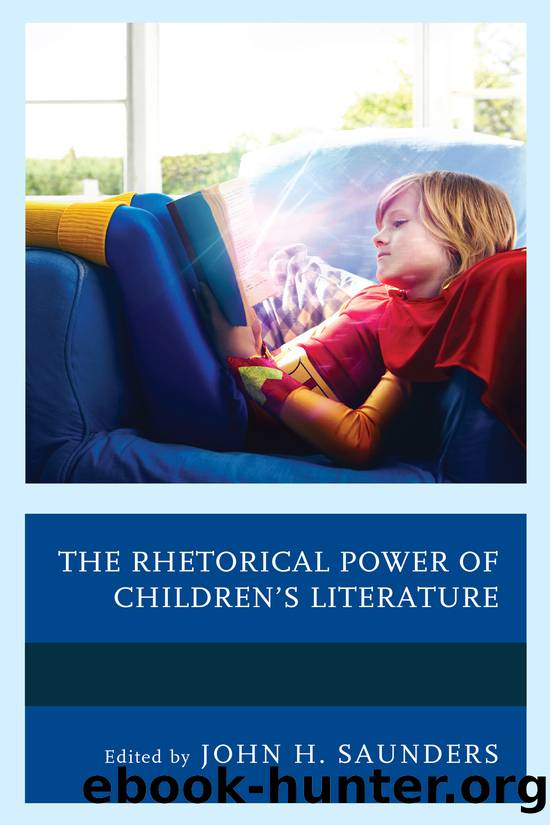The Rhetorical Power of Children's Literature by unknow

Author:unknow
Language: eng
Format: epub
Publisher: Lexington Books/Fortress Academic
Chapter 7
âWhy Do You Hurt These Children?â The Rhetoric of âRisky Storiesâ in Childrenâs Literature
Lauren Lemley
Teaching children about troubling and traumatic historical moments is a difficult and critically important task that evokes a sense of urgency in any elementary social studies classroom as students learn about the Holocaust, the civil rights movement, 9/11, and many other tragic moments from the past. Of course, as Maurice Sendak poignantly stated in his 1994 preface to a book of pictures drawn by child survivors of war: âThe children know. They have always known. But we choose to think otherwise; it hurts to know the children know. The children see. If we obfuscate, they will not see. Thus we conspire to keep them from knowing and seeing. . . . It is a sad comedy: the children knowing and pretending they donât know to protect us from knowing they know.â1 Despite understanding that children need to learn about difficult historical moments and even our realization that they already know more than we wish they did, talking to children about trauma remains troubling. But while some of these lessons have the advantage of a contemporary setting and context that an elementary school student would have some experience with, teaching children about traumatic events that occurred centuries ago becomes even more challenging because the eventâs cultural and religious complexities are now so far removed from twenty-first-century understanding. Indeed, in the case of the Salem witch trials, scholars from a number of fields continue to debate the true causes and nature of the event itself. Thinking of how to make such a nuanced historical episode intelligible to children is no easy task. It is the question of how to communicate such fraught historical moments to children through literature that lies at the heart of this chapter.2
History textbooks offer children brief, oversimplified, and often inaccurate information about the Salem crisis. But, because these âofficialâ American public memories of the witch trials are often so vague, they have virtually invited rhetors working with âvernacularâ public memories to play with, reframe, and at times entirely change the events that took place during the 1690s with little regard for preserving historical accuracy or reverence for the trialsâ victims.3 Such wildly inaccurate depictions include witches âsucking the lifeâ out of children (Hocus Pocus), Salem as home to the United Statesâ equivalent of Hogwarts (Harry Potter and The Goblet of Fire), and witches who fly around on brooms terrorizing colonial towns by eating children and facing the threat of burning at the stake (The Simpsons, âTreehouse of Horror VIIâ).
Crafting childrenâs historical fiction about the Salem witchcraft crisis is no easy task. But beyond the question of accuracy lie equally important questions about motives, such as why do authors choose to alter the historical record in their stories, and what do these inaccuracies communicate to a young audience? In this chapter, I consider the task of writing such stories rhetorically by overviewing current scholarship on historical fiction written to teach children about traumatic events
Download
This site does not store any files on its server. We only index and link to content provided by other sites. Please contact the content providers to delete copyright contents if any and email us, we'll remove relevant links or contents immediately.
Cecilia; Or, Memoirs of an Heiress — Volume 1 by Fanny Burney(31352)
Cecilia; Or, Memoirs of an Heiress — Volume 3 by Fanny Burney(30950)
Cecilia; Or, Memoirs of an Heiress — Volume 2 by Fanny Burney(30907)
The Lost Art of Listening by Michael P. Nichols(6485)
We Need to Talk by Celeste Headlee(4881)
Asking the Right Questions: A Guide to Critical Thinking by M. Neil Browne & Stuart M. Keeley(4600)
On Writing A Memoir of the Craft by Stephen King(4222)
Dialogue by Robert McKee(3593)
I Have Something to Say: Mastering the Art of Public Speaking in an Age of Disconnection by John Bowe(3520)
Pre-Suasion: A Revolutionary Way to Influence and Persuade by Robert Cialdini(3422)
Elements of Style 2017 by Richard De A'Morelli(2946)
The Book of Human Emotions by Tiffany Watt Smith(2779)
Good Humor, Bad Taste: A Sociology of the Joke by Kuipers Giselinde(2560)
Name Book, The: Over 10,000 Names--Their Meanings, Origins, and Spiritual Significance by Astoria Dorothy(2498)
Fluent Forever: How to Learn Any Language Fast and Never Forget It by Gabriel Wyner(2451)
The Grammaring Guide to English Grammar with Exercises by Péter Simon(2397)
Why I Write by George Orwell(2362)
The Art Of Deception by Kevin Mitnick(2304)
Don't Sleep, There Are Snakes by Daniel L. Everett(2220)
